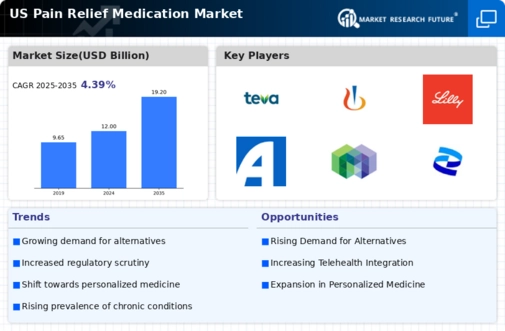Regulatory Changes and Market Access
Regulatory changes in the US healthcare landscape are shaping the pain relief-medication market. Recent policy shifts aimed at improving access to pain management therapies have the potential to enhance market dynamics. For instance, the introduction of streamlined approval processes for new pain relief medications may facilitate quicker market entry for innovative products. Additionally, the Centers for Medicare & Medicaid Services has expanded coverage for certain pain management treatments, which could increase patient access to necessary medications. These regulatory developments are likely to create a more favorable environment for the pain relief-medication market, encouraging investment and innovation. However, stakeholders must remain vigilant in navigating the complexities of regulatory compliance to fully leverage these opportunities.
Increasing Prevalence of Chronic Pain
The rising incidence of chronic pain conditions in the US is a primary driver for the pain relief-medication market. According to the National Institutes of Health, approximately 20.4% of adults in the US experience chronic pain, which translates to over 50 million individuals. This growing patient population necessitates effective pain management solutions, thereby propelling demand for various pain relief medications. As healthcare providers seek to address this widespread issue, the pain relief-medication market is likely to expand significantly. Furthermore, the increasing awareness of chronic pain's impact on quality of life has led to a greater emphasis on treatment options, further stimulating market growth. The pain relief-medication market must adapt to these changing dynamics to meet the needs of this substantial demographic.
Advancements in Pharmaceutical Research
Innovations in pharmaceutical research are driving the evolution of the pain relief-medication market. Recent developments in drug formulation and delivery systems have led to the introduction of more effective and targeted pain relief medications. For instance, the emergence of long-acting formulations and combination therapies has enhanced pain management strategies. The National Institutes of Health reports that investment in pain research has increased, with funding reaching approximately $500 million annually. This influx of resources is likely to yield new therapeutic options, thereby expanding the pain relief-medication market. Additionally, the focus on developing non-opioid alternatives is becoming increasingly prominent, as stakeholders aim to address the opioid crisis while still providing effective pain relief. The pain relief-medication market must remain vigilant in adapting to these advancements to maintain competitiveness.
Rising Awareness of Pain Management Options
There is a growing awareness among patients and healthcare providers regarding the importance of effective pain management, which is positively influencing the pain relief-medication market. Educational initiatives and advocacy efforts have led to increased recognition of chronic pain as a legitimate health concern. This heightened awareness is prompting patients to seek out various pain relief options, including medications, physical therapy, and alternative treatments. According to a survey conducted by the American Pain Society, nearly 80% of respondents reported that they actively seek information about pain management strategies. This trend indicates a shift towards more informed patient choices, which is likely to drive demand for diverse pain relief medications. The pain relief-medication market must capitalize on this trend by providing comprehensive information and access to a range of treatment options.
Aging Population and Associated Health Issues
The demographic shift towards an aging population in the US is a significant driver for the pain relief-medication market. As individuals age, they often experience a higher prevalence of chronic pain conditions, such as arthritis and neuropathy. The US Census Bureau projects that by 2030, approximately 20% of the population will be aged 65 and older, which will likely increase the demand for pain relief medications. This demographic trend necessitates a robust response from the pain relief-medication market, as older adults typically require tailored pain management solutions. Furthermore, the healthcare system is increasingly focused on improving the quality of life for seniors, which further emphasizes the need for effective pain relief options. The pain relief-medication market must adapt to these demographic changes to effectively serve this growing segment.























Leave a Comment